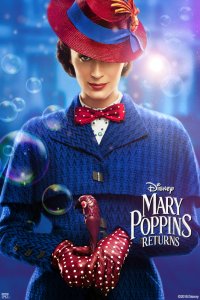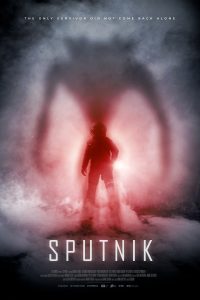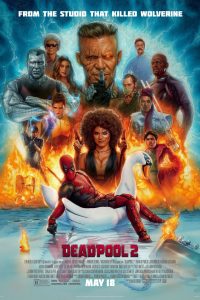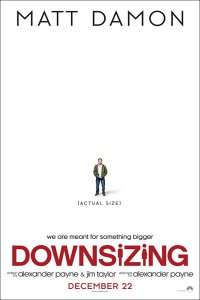Practically Imperfect in Every Way: Gary Westfahl Reviews Mary Poppins Returns
 Since Mary Poppins Returns was one of those rare films falling within my area of expertise that was of interest to my other family members, I watched it in the company of my wife and granddaughter, and I should report that six-year-old Serena Michelle Kong thoroughly enjoyed the film, explaining that she found it just as delightful as its esteemed precursor Mary Poppins (1964). And perhaps, that is the only reaction that matters, since the film was clearly most interested in entertaining children. However, the whole idea of family films is to also please the adults who accompany those children, and Rob Marshall’s film proved far less successful than the original film in achieving that aim. For Serena’s grandparents, only occasionally enthralled by what they were watching, were more frequently bored or irritated, for reasons that explain why contemporary filmmakers so often seem incapable of producing genuinely charming fantasies.
Since Mary Poppins Returns was one of those rare films falling within my area of expertise that was of interest to my other family members, I watched it in the company of my wife and granddaughter, and I should report that six-year-old Serena Michelle Kong thoroughly enjoyed the film, explaining that she found it just as delightful as its esteemed precursor Mary Poppins (1964). And perhaps, that is the only reaction that matters, since the film was clearly most interested in entertaining children. However, the whole idea of family films is to also please the adults who accompany those children, and Rob Marshall’s film proved far less successful than the original film in achieving that aim. For Serena’s grandparents, only occasionally enthralled by what they were watching, were more frequently bored or irritated, for reasons that explain why contemporary filmmakers so often seem incapable of producing genuinely charming fantasies.
Certainly, Marshall and writers David Magee and John DeLuca were endeavoring to replicate the magic of the 1964 film, so much so that the film’s credits should really include the authors of the first film’s screenplay, Bill Walsh and Don DaGradi (though the man who did its special effects, Peter Ellenshaw, is recognized in the closing credits). Certain elements from the original film are simply duplicated, like the disruptive cannon of Admiral Boom (David Warner) and Mary Poppins’s talking umbrella, and some extended sequences are almost exactly copied: instead of taking her friend Bert and her young charges into the world of a chalk drawing, this Mary Poppins (Emily Blunt) takes her friend Jack (Lin-Manuel Miranda) and her young charges into the world of an etching on a ceramic bowl. Instead of visiting eccentric Uncle Albert, who laughs and flies around, the group visits Mary’s eccentric cousin Topsy (Meryl Streep), who cackles as her house turns upside down. Instead of Bert leading a troupe of chimney sweeps in energetically dancing on London’s rooftops, Jack leads a troupe of lamplighters in energetically dancing through London’s streets. Instead of a lovable old Bird Lady selling food for the birds, we have a lovable old Balloon Lady (Angela Lansbury) selling balloons, which also replace the flying kite that concluded the original film.
The only major sequence without an analogue in the original film is an underwater adventure that seems borrowed from Disney’s most blatant effort to imitate Mary Poppins, Bedknobs and Broomsticks (1971) (also written by Walsh and DaGradi). To give credit where credit is due, one must say that an enormous amount of effort and creativity went into the staging of these scenes, but audiences will also feel that these are all things they have seen before. Still, I remember that when they were growing up, my children used to love watching the same movie again and again, so Serena may have loved Mary Poppins Returns precisely because it was so similar to the first film.
The larger problem is that all this colorful whimsy is embedded in a contrived story that is needlessly dark. A grown-up Michael Banks (Ben Whishaw) is still grieving over the recent death of his wife, which has also devastated his children Anabel (Pixie Davies), John (Nathanael Saleh), and Georgie (Joel Dawson). Since Banks cannot manage his money, he has fallen behind on loan payments, which will soon enable Wilkins (Colin Firth), the evil man who has taken over his father’s bank, to seize his house and render his family homeless. Setting up this unhappy scenario needlessly delays the appearance of Mary Poppins, getting the film off to a very slow start, and even when the magical governess finally arrives, she seems uninterested in thwarting Wilkins’s scheme, focusing instead on merely diverting the Banks children while they await their sad fate. Needless to say, though, she is ultimately instrumental in arranging a miraculous deux ex machina to impose the necessary happy ending. (Perhaps, this theme of financial distress was suggested by the realization that a film set a generation after the original film’s 1910 would necessarily take place during the Great Depression, although this film’s London continues to look rather Edwardian.)
All of this doom and gloom is in stark contrast to the original film, which illustrates a point that no one in Hollywood now seems to understand: effective stories don’t have to have villains; effective stories don’t have to place their characters in desperate peril. There are no villains in Mary Poppins: true, the parents are insufficiently attentive to their children, but they clearly love them and are finally schooled on the overriding importance of tending to their children’s needs. At one time, the people at the bank are upset enough to fire the father, but they see the error of their ways and rehire and promote him. The absence of any sinister menaces or looming disasters is what allows the children – and the audience – to relax and enjoy all of Mary Poppins’s improbable escapades. In this film, the prospect of imminent homelessness and poverty simply spoils all the fun: how on Earth can these children really enjoy an interlude in a fantasy world if they know that they soon must return to the real world, pack up their belongings, and get thrown out of their house? The film’s grimness even invades one of the fantasy sequences, when one of the animated characters on the ceramic bowl is revealed to be a scoundrel, intent on stealing all the children’s belongings, who also puts their lives in danger.
Watching this film, I was oddly reminded of another wonderful story for young readers – Steven Gould’s Jumper (1992) – that was utterly ruined by filmmakers following the rules for modern films. Gould’s hero discovers that he can teleport himself to any place in the world and proceeds to have some leisurely, untroubled adventures as he employs his powers; the 2008 film (review here) instead makes his situation depressing and terrifying, as it introduces some villains, the Paladins, who are determined to track down and kill every person who can teleport. Gould’s engaging novel has gone on to spawn successful sequels, but after the repugnant film proved insufficiently profitable, plans for a sequel were canceled. But I should not belabor the lesson to be learned from this, since it has come up in other previous reviews.
As a less objectionable departure from the original film, Mary Poppins Returns includes a genuine love story, another ingredient that filmmakers now believe must be added to every popular film. In the 1964 film, it did sometimes seem that Mary Poppins and Bert were an item, but we knew from the start that the story would end with Mary Poppins’s departure, and despite all his charm, it was always evident that a woman with her abilities would never choose a lowly laborer like Bert as her lifelong companion. Here, as Serena astutely noted, Emily Blunt’s Mary Poppins looks rather older than Julie Andrews’s Mary Poppins, effectively eliminating her as a romantic interest for the figure who replaces Bert, the obviously younger Jack. But the grown-up Jane Banks (Emily Mortimer) is conveniently still unmarried, and because she is also a fervent crusader for workers’ rights, she might be willing to consider one of them as a suitor. Indeed, other characters in the film, most prominently the housekeeper Ellen (Julie Walters), believe that Jane and Jack would be an ideal couple and strive to bring them together. And while there can be no passionate kissing in a family film, the story does conclude with Jane and Jack holding hands, indicating that they are destined to get together (and perhaps setting up a sequel wherein Mary Poppins returns again to watch over their children).
Further, unlike the original film, Marshall’s film conspicuously lacks a message, and this is somewhat understandable because the message in the 1964 film would not be palatable to twenty-first-century audiences. Julie Andrews’s Mary Poppins comes into the lives of the dysfunctional Banks family to address two related issues: the children are not obeying their elders, and the parents aren’t spending enough time with their children. Mary Poppins solves these problems by teaching the children to be obedient to adults, and teaching the parents to spend more time with their children. Today, however, we no longer expect children to defer to their parents’ wishes – indeed, in programs like Serena’s current favorite, The Loud House (2016- ), the children are effectively in control of the family – and the 1964 film’s argument that mothers should abandon working to focus on their children could never be advanced now.
Hence, in this film, the Banks family is not dysfunctional at all: while he does get angry with them at one point, Michael Banks is manifestly devoted to his children from the start, and his three children do not constantly misbehave. Their problem is a purely practical one: Michael Banks doesn’t have enough money, and Mary Poppins presumably returns so she can assist him in obtaining enough money – although as noted she spends most of the film appearing utterly oblivious to that issue. But the difficulty to be overcome here lacks any emotional resonances, making Mary Poppins Returns an essentially empty film. This is another common characteristic of contemporary films: messages can be controversial, and seeking to avoid controversy at all costs, filmmakers respond by eliminating all messages except those that are considered universally acceptable. (True, we are told that Jane Banks is agitating for the working class, but her actual goals are never specified.) So it is that this film boldly asserts: it’s good for parents to love their children! It’s good for children to love their parents! And it’s good for attractive young people to fall in love! (In one scene, Mary Poppins opines that “Some people think a great deal too much,” a fitting sentiment for a film that so scrupulously avoids giving viewers anything to think about.)
In confronting the task of filming a sequel to a beloved classic, the makers of Mary Poppins Returns additionally faced two major challenges: the original film seemed perfectly cast, and it was filled with memorable songs, including one, “Chim-Chim-Cheree,” that won an Academy Award. As is so often the case, this sequel fails to match the original in these respects. Emily Blunt is masterful in presenting the cold and businesslike aspect of Mary Poppins’s personality, but she inadequately conveys the underlying warmth that distinguished the work of Julie Andrews. As for Lin-Manuel Miranda, he generally seems an inspired choice to replace Dick Van Dyke, yet he is also trying too hard to be appealing; there is something overstated and theatrical in his portrayal of Jack, which is hardly surprising given his Broadway background. One feels sorry for Colin Firth, a subtle actor haplessly trying to bring to life a cardboard character recalling the mortgage-foreclosing Snidley Whiplash, and the film also wastes the talents of Julie Walters and David Warner. Other performers are generally capable, if unremarkable, with one exception: just as Ed Wynn’s appearance as Uncle Albert was the original film’s least likable sequence, Meryl Streep’s cameo as Cousin Topsy is this film’s weakest moment, as even a brilliant actress proves incapable of bringing to life a horribly ill-conceived character. (There is one amusing in-joke: since Streep was originally celebrated for performing with a variety of different accents, a character remarks that Topsy has an “unusual accent.”) It is also a tradition for sequels to bring back actors from the original film in small roles, yet this film does so ineffectually: the first Jane Banks, Karen Dotrice, goes unnoticed in a brief role, and the film waits far too long to bring on Dick Van Dyke and gives him too little to do. (The absence of his co-star Julie Andrews is conspicuous, but though she was offered a role, she declined to appear.)
As for the songs, they are mostly inferior rehashes of songs from the original film; significantly, to underlie particularly emotional moments, the film’s score resorts to snippets of melodies from two of that film’s songs: “A Spoonful of Sugar” and “Let’s Go Fly a Kite.” There is precisely one excellent song that has no equivalent in the original film – “The Place Where Lost Things Go” – that accompanies one of the few moments in the film that is genuinely moving; there are also some clever, even risqué, lines in “A Cover Is Not the Book.” Overall, though, it seems unfortunate that Disney didn’t hire Lin-Manuel Miranda to write some songs for the film, as he did for the animated Moana (2016), though recalling his stage musical Hamilton the producers possibly feared that his music would be too jarringly modern for a film set in the 1930s (though Miranda does work in a little rapping here and there).
Long ago, while epitomizing the career of Robert Stevenson, the underrated director of Mary Poppins, I commented that “Emulating Robert Stevenson is harder than it looks,” and this film again validates that observation. Logically, given the enormously superior special effects now achievable, and the larger amounts of time and money devoted to making films, one might assume that it would be easy to improve upon a film made over fifty years ago. Yet producing an excellent film requires wisdom as well as bountiful resources, and wisdom is a quality one rarely observes in a film industry that is now devoted primarily to avoiding risks at all costs. Even while basking in the success of Mary Poppins, Walt Disney himself was far too wise to summon Julie Andrews and Dick Van Dyke back to the set to churn out a sequel to the film, recognizing that it is always more rewarding to keep attempting to do something new. His successors, however, believe that the safest course of action is to replicate the films that have succeeded in the past. Well, I suppose, that can keep six-year-olds happy, even if their parents and grandparents are less than pleased with the results.
Directed by Rob Marshall
Written by David Magee, based on a story by David Magee, Rob Marshall, and John DeLuca, based on the Mary Poppins novels by P. L. Travers
Starring Emily Blunt, Lin-Manuel Miranda, Ben Whishaw, Emily Mortimer, Joel Dawson, Nathanael Saleh, Pixie Davies, Julie Walters, Meryl Streep, Colin Firth, Jeremy Swift, Kobna Holdbrook-Smith, Dick Van Dyke, Angela Lansbury, David Warner, Jim Norton, and Noma Dumezweni
Gary Westfahl has published 28 books about science fiction and fantasy, including Science Fiction Quotations: From the Inner Mind to the Outer Limits (2005), The Spacesuit Film: A History, 1918-1969 (2012), and A Sense-of-Wonderful Century: Explorations of Science Fiction and Fantasy Films (2012); excerpts from these and his other books are available at his World of Westfahl website (here). He has also published hundreds of articles, reviews, and contributions to reference books. His most recent books are the three-volume A Day in a Working Life: 300 Trades and Professions through History (2015), An Alien Abroad: Science Fiction Columns from Interzone (2016), the co-edited Bridges to Science Fiction and Fantasy: Outstanding Essays from the J. Lloyd Eaton Conferences (2018), and Arthur C. Clarke, part of the University of Illinois Press’s Modern Masters of Science Fiction series.
©Locus Magazine. Copyrighted material may not be republished without permission of LSFF.








